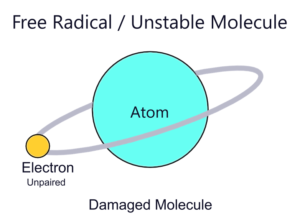Modern diseases caused by oxidative stress
A multitude of modern diseases stem from clusters of cells that have undergone damage due to oxidative stress. These cells find themselves in a state of electron deficiency caused by reactive oxygen species (ROS), often referred to as free radicals.
Cellular damage caused by oxidative stress arises due to an imbalance between free radicals and antioxidants. This imbalance occurs when your levels of free radicals are elevated and your levels of antioxidants are diminished, leading to potential harm to cells, proteins, and DNA.
Typically, a free radical refers to an atom or molecule that possesses one or more unpaired electrons.
Free radicals, lacking an electron on one side, actively seek healthy molecules and extract electrons from them as they strive to restore balance.
In a healthy cell, a stable molecule possesses paired electrons. However, if one electron is removed, the molecule becomes unpaired and subsequently unstable.


Free radicals are not content with merely seizing a single electron from a lone molecule; they incite a sequence of events wherein they extract electrons from adjacent molecules consecutively. This initiates a domino effect, causing oxidative harm to proliferate to other areas of the body, resulting in the progressive damage of additional healthy cells.
This is how severe diseases, such as cancer, progress.
Other typical diseases associated with oxidative stress:
- Nervous System:
Cerebral edema, cerebral infarction (stroke), epilepsy, autonomic disorders of the nervous system. - Respiratory / Hematologic System:
Pneumonia, emphysema, leukemia, hyperlipidemia, hypertension. - Circulatory System:
Myocardial infarction (heart attack), arrhythmia, atherosclerosis. - Digestive / Endocrine System:
Gastric ulcers, cirrhosis, diabetes. - Supportive Tissue System / Skin:
Rheumatoid arthritis (joint system), atopic dermatitis.
